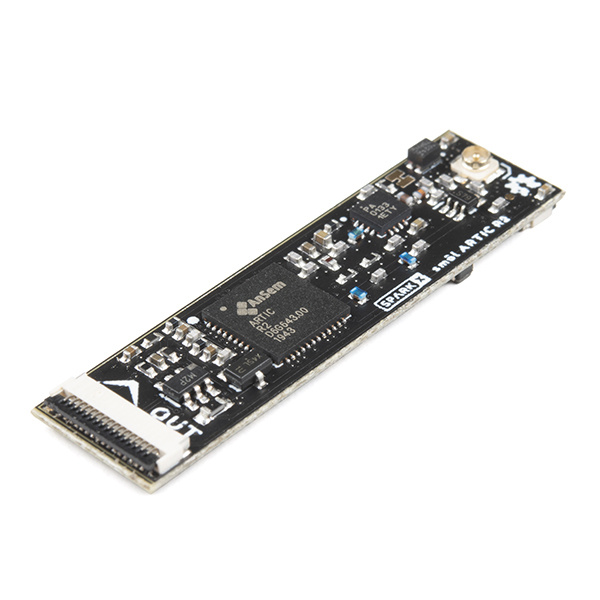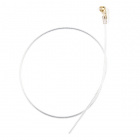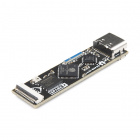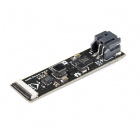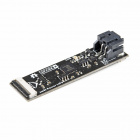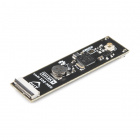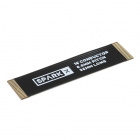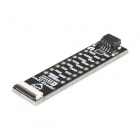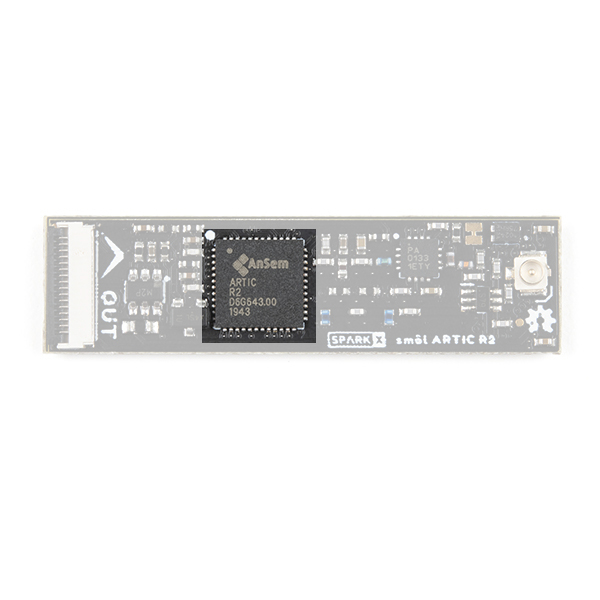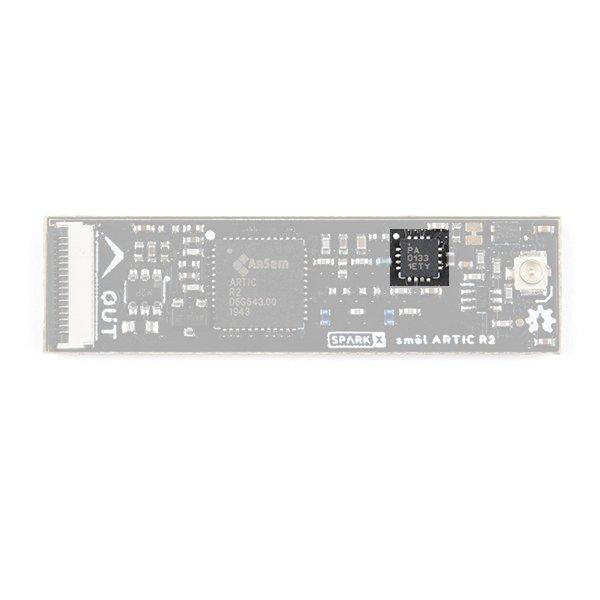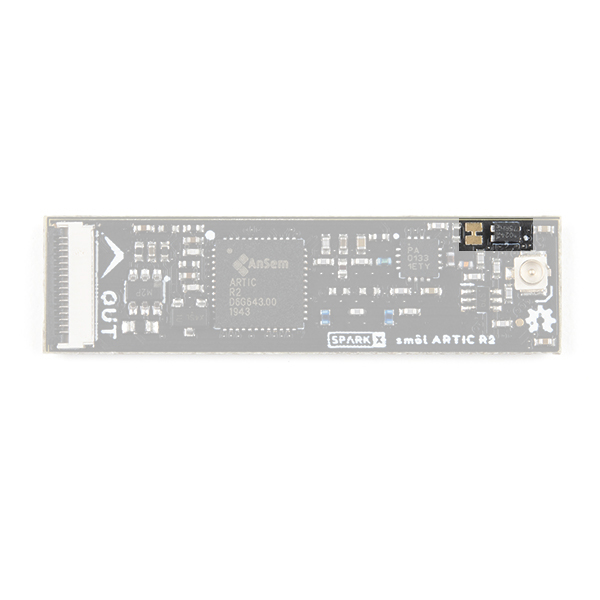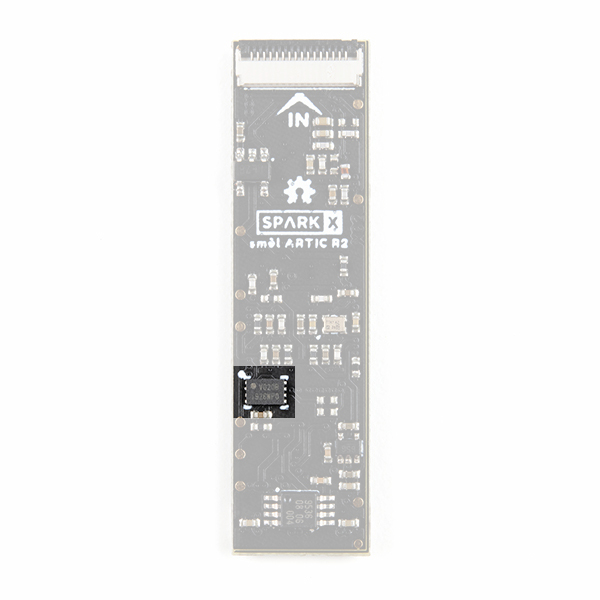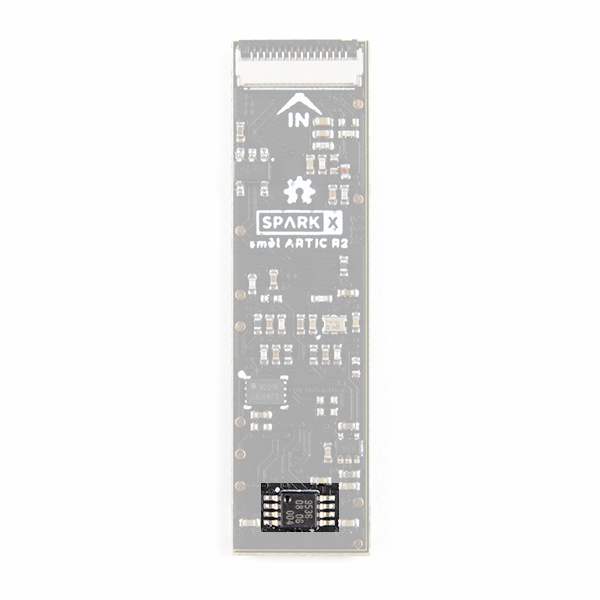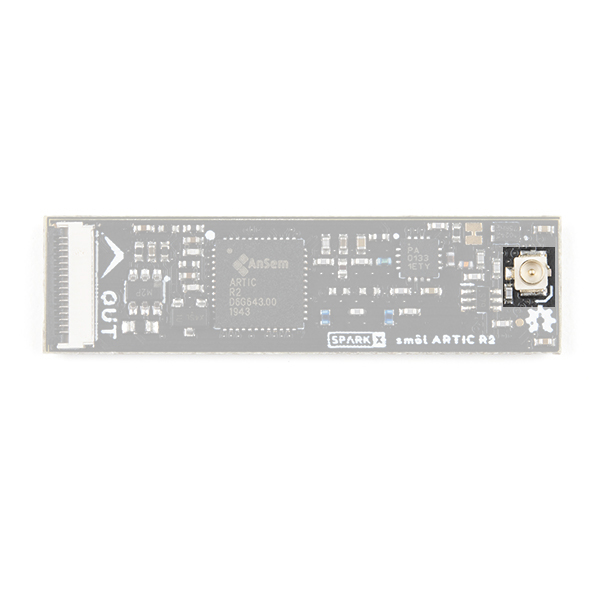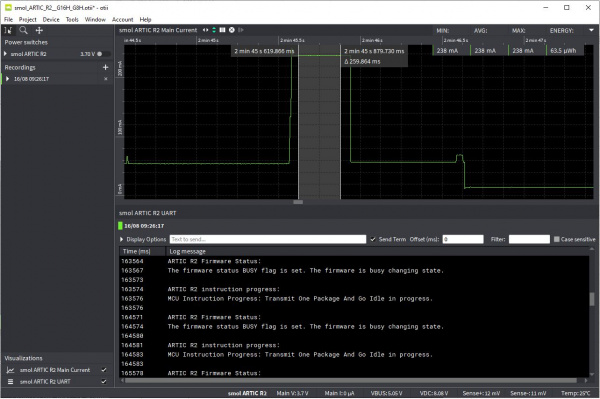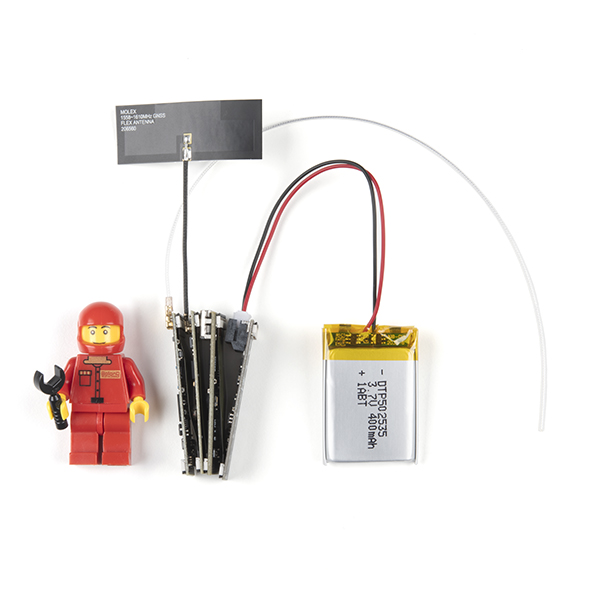smôl ARTIC R2 Hookup Guide
Introduction
smôl is a new board format and, as the name suggests, they're really small!
smôl ARTIC R2
SPX-18618The smôl ARTIC R2 Peripheral Board is a complete satellite transceiver for the ARGOS satellite network.
When we designed our ARGOS Satellite Transceiver Shield - ARTIC R2, we knew that people would want to use it for applications like wildlife tracking. In fact, all programs using ARGOS have to be related in some way or other to environmental protection, awareness or study, or to protecting human life. But what if you want to develop something much smaller? Say, a small dart for whale tracking, or a small backpack for avian tracking. Or you just need your battery to last for months. smôl is designed to meet those needs.
Each smôl board measures just 1.60" by 0.42" (40.6mm by 10.7mm). We made the boards just wide enough so we could squeeze USB-C and 16-way Flexible Printed Circuit (FPC) connectors on there. Some of the boards have components on both top and bottom layers which again helps keep the boards small.
smôl boards are designed to stack one on top of the other, using 16-way 0.5mm-pitch FPCs to provide the interconnect from one board to the next. Each board has an IN FPC connector on the bottom layer and an OUT FPC connector on the top layer. The boards stack in a zig-zag daisy chain; signals and power are passed from one board to the next up and down the chain through the FPCs.
Required Materials
As a minimum, you're going to need a suitable antenna:
The ARTIC R2 Peripheral Board is part of the smôl ecosystem. Why not pair it with one of the smôl Processor Boards?
smôl ESP32
SPX-18619
To be able to reduce the sleep current below 10µA, you're going to want to pair the ESP32 with one of our intelligent smôl Power Boards:
Of course, a satellite tracking system needs to know where it is. Why not add a smôl ZOE-M8Q GNSS board to your smôl ecosystem?
smôl ZOE-M8Q
SPX-18623
Don't forget that you will need Flexible Printed Circuits to connect your smôl boards together. You're going to need one FPC per board. Our 36mm FPC is the perfect length if you want the smôl boards to stack neatly, one on top of the other.
Need to do some prototyping with smôl? Or want to connect your smôl stack to another Qwiic board? The smôl Header is perfect for that:
Suggested Reading
This is the hookup guide for the smôl ARTIC R2 Peripheral Board. Click the button below if you want to find out more about smôl itself:
Click the button below if you want to find out more about communicating with ARGOS and the ARTIC R2:
We recommend taking a look through the following tutorials if you are not familiar with the concepts covered in them:
Serial Peripheral Interface (SPI)
I2C
Three Quick Tips About Using U.FL
ARGOS & ARTIC R2
Is your project linked to environmental protection, awareness or study, or to protecting human life? Perhaps you are developing a wildlife tracker, ocean buoy, environmental monitoring system or need to transfer emergency medical information? Do you need to be able to transmit and receive data anywhere? If so, this is the smôl product for you! Our smôl ARTIC R2 allows you to send and receive short bursts of data via the ARGOS satellite network, anywhere on Earth including the Polar regions.
The ARGOS satellite system has been around for quite a while. It was created in 1978 by the French Space Agency (CNES), the National Aeronautics and Space Administration (NASA) and the National Oceanic and Atmospheric Administration (NOAA), originally as a scientific tool for collecting and relaying meteorological and oceanographic data around the world. Today, ARGOS is revolutionising satellite communication, adding a constellation of 25 nanosatellites to complement the 7 traditional satellites carrying ARGOS instrumentation. The first of these, ANGELS, is already in operation and SparkFun were among the first users to transmit data to ANGELS in October 2020. When the constellation is complete, there will be a maximum of 10-15 minutes between satellite passes.
The ARTIC R2 is an integrated, low-power, small-size ARGOS 2/3/4 single chip transceiver. ARTIC implements a message based wireless interface. For satellite uplink communication, ARTIC will encode, modulate and transmit provided user messages. For downlink communication, ARTIC will lock to the downstream, demodulate and decode and extract the satellite messages. The ARTIC can transmit signals in frequency bands around 400MHz and receive signals in the bands around 466MHz, in accordance with the ARGOS satellite system specifications.
The smôl ARTIC R2 has been tested and certified by Kinéis. Compared to other satellite communication systems, the smôl ARTIC R2 has a much lower current draw and will work with a very simple, very lightweight quarter-wave wire antenna. The ARTIC R2 chipset on our board operates from 3.3V and the on-board flash memory enables fast boot times. If you don’t need the full transmit power, or want to conserve your battery life, you can transmit at reduced power too thanks to opto-isolated gain control.
Our Arduino Library makes it really easy to get up and running with ARGOS. We’ve provided a full set of examples which will let you: configure the ARTIC R2 chipset; predict the next satellite pass; receive allcast and individually-coded messages; transmit messages using ARGOS 2, 3 and 4 encoding. There are dedicated examples for the smôl ARTIC R2.
Hardware Overview
In this section we'll cover what's included on the smôl ARTIC R2 Peripheral Board.
ARTIC R2
The heart of the smôl ARTIC R2 is, of course, the ARTIC R2 transceiver itself. This is a clever chip containing a Digital Signal Processor (DSP) which modulates transmit messages and demodulates received messages. The DSP can boot from on-board flash memory or from an external microcontroller via SPI. When transmitting, it produces a 1mW (0dBm) output signal which is fed to a separate power amplifier.
Our Arduino Library does all of the heavy lifting for you. By default, the library will tell the ARTIC R2 DSP to boot from the on-board flash memory. However, by changing one line of code, you can instead boot via SPI with your microcontroller providing the firmware for the DSP.
RF Amplifier
During transmit, the RFPA0133 power amplifier boosts the 0dBm (1mW) signal from the ARTIC R2.
By default, the amplifier uses full gain and boosts the signal to approximately 25.8dBm (380mW). If you are using ARGOS 2 or 3 modulation and are transmitting from a 'noisy' environment, like a city, then you are probably going to need to use full power to ensure your messages get through. However, if you are using ARGOS 4 modulation and/or are transmitting from a 'quiet' environment, like the tundra or the ocean, then you will be able to transmit at reduced power.
Gain Control
There are two ways to reduce the smôl ARTIC R2 transmit power. You can adjust the gain through software and the on-board opto-isolated gain control circuit.
Our Arduino Library can reduce the gain for you. If you call:
language:c
myARTIC.attenuateTXgain(true);
from inside your code, the opto-isolator will pull the RFPA0133's G8 pin low, reducing the gain by approximately 5dB. This also has the advantage of reducing the transmit current by approximately 80mA.
If you are experimenting with ARGOS 4 modulation, you may want to reduce the gain even further. You can do that by opening the split-pad jumper next to the opto-isolator. Opening the jumper will pull the RFPA0133's G16 pin low and will reduce the gain by approximately 11dB. If you haven't used jumpers before, please check out our tutorial.
How to Work with Jumper Pads and PCB Traces
Flash Memory
If you turn the smôl ARTIC R2 over, you will be able to see the small flash memory chip.
During production testing at SparkFun, we program the flash memory with the ARTIC R2 firmware (ARTIC006) and a Platform ID allocated by CLS. You will need to register the Platform ID on your ARGOS account to activate it.
GPIO Expander
The larger chip on the bottom of the board is a PCA9536 I2C GPIO expander.
smôl only supports two GPIO signals, so we added a separate I2C GPIO expander to allow the ARTIC R2 RESETB, INT1 and BOOT signals, plus the RF amplifier G8 pin, to be controlled via I2C.
You won't need to communicate with the GPIO expander directly, our Arduino Library will do that for you, we're just letting you know why that chip is there.
Antenna
The antenna connection for the ARTIC R2 is u.FL.
Check out our tutorial if you haven't used u.FL before:
Three Quick Tips About Using U.FL
FPC Connections
Like all of our smôl boards, the ARTIC R2 Peripheral Board is equipped with two 16-way 0.5mm-pitch Flexible Printed Circuit connectors. FPCs are used to link the smôl boards together in a daisy-chain.
The pin-out for the smôl ARTIC R2 IN connector is as follows:
| IN Connector Pin No. | Signal Name | Function | Notes |
|---|---|---|---|
| 1 | PROC_PWR_EN | Processor Power Enable | Not used |
| 2 | 3V3 | 3.3V Power Rail | |
| 3 | GND | Power Ground / 0V | |
| 4 | SCLK | SPI Clock | Used to communicate with the ARTIC R2 |
| 5 | COPI | SPI Controller Out Peripheral In | Used to communicate with the ARTIC R2 |
| 6 | CIPO | SPI Controller In Peripheral Out | Used to communicate with the ARTIC R2 |
| 7 | CS0 | SPI Chip Select 0 | Used to communicate with the ARTIC R2 |
| 8 | CS1 | SPI Chip Select 1 | Connected to Pin 7 (CS0) on the OUT connector |
| 9 | CS2 | SPI Chip Select 2 | Connected to Pin 8 (CS1) on the OUT connector |
| 10 | GPIO0 | Power Control | Pull high to enable power for the ARTIC R2 |
| 11 | GPIO1 | General Purpose Input / Output 1 | Connected to Pin 10 (GPIO0) on the OUT connector |
| 12 | SDA | I2C Data | Used to communicate with the PCA9536 GPIO expander |
| 13 | SCL | I2C Clock | Used to communicate with the PCA9536 GPIO expander |
| 14 | GND | Power Ground / 0V | |
| 15 | 3V3 | 3.3V Power Rail | |
| 16 | V_USB | USB Power Rail (5V) | Not used |
The pin-out for the smôl ARTIC R2 OUT connector is as follows:
| OUT Connector Pin No. | Signal Name | Function | Notes |
|---|---|---|---|
| 1 | PROC_PWR_EN | Processor Power Enable | Not used |
| 2 | 3V3 | 3.3V Power Rail | |
| 3 | GND | Power Ground / 0V | |
| 4 | SCLK | SPI Clock | Used to communicate with the ARTIC R2 |
| 5 | COPI | SPI Controller Out Peripheral In | Used to communicate with the ARTIC R2 |
| 6 | CIPO | SPI Controller In Peripheral Out | Used to communicate with the ARTIC R2 |
| 7 | CS0 | SPI Chip Select 0 | Connected to Pin 8 (CS1) on the IN connector |
| 8 | CS1 | SPI Chip Select 1 | Connected to Pin 9 (CS2) on the IN connector |
| 9 | CS2 | SPI Chip Select 2 | Not connected |
| 10 | GPIO0 | General Purpose Input / Output 0 | Connected to Pin 11 (GPIO1) on the IN connector |
| 11 | GPIO1 | Not connected | |
| 12 | SDA | I2C Data | Used to communicate with the PCA9536 GPIO expander |
| 13 | SCL | I2C Clock | Used to communicate with the PCA9536 GPIO expander |
| 14 | GND | Power Ground / 0V | |
| 15 | 3V3 | 3.3V Power Rail | |
| 16 | V_USB | USB Power Rail (5V) | Not used |
We use a technique called waterfalling on the CS and GPIO signals. If you haven't used waterfalling before, please check out the smôl Hookup Guide.
Current Draw
If you are using the smôl ARTIC R2 to develop your own wildlife tracker, you will of course be very interested in how much current the board draws.
The fantastic Otii Arc Power Analyzer has allowed us to capture the ARTIC R2's exact peak transmit current draw at all four gain settings, and to study the average current drawn when the chip is idle. We've used this data to help optimize the code in this example to extend the battery life as much as possible when using the smôl ARTIC R2 with the smôl ESP32 Processor Board, smôl ZOE-M8Q GNSS Board and the smôl Power Board LiPo.
Maximum Gain (G16 High, G8 High)
The picture below shows the current draw captured by Otii Arc for a complete transmit cycle using this example. The gain here is set to maximum.
At the start of the transmit cycle, the ESP32 Processor Board is woken up by the Power Board. It turns on the ZOE-M8Q GNSS board and waits for a fix. The current draw here is approximately 100mA for ~10 seconds.
Once the ESP32 has a location fix, it can calculate the time of the next ARGOS satellite pass. The power board woke the ESP32 up 1 minute before the start of the next pass, so the ESP32 goes in and out of light sleep for the next ~30 seconds.
The ARTIC R2 is powered on at the 40 second mark and the first of five transmits takes place just after the one minute mark.
The code example transmits five times on each satellite pass. The gap between the transmits is 90 seconds with a mandatory ±10% jitter. In between, you can see the ESP32 going in and out of light sleep with the ARTIC R2 being powered up 20-30 seconds before the next transmit is due.
The phenomenal data captured by Otii Arc allows us to zoom right in on the transmit itself and capture the true maximum current draw:
It's then child's play to extract the data we need!
Current Draw Summary
Below is a summary of the peak transmit current draw for the four ARTIC R2 gain settings. The RFPA0133 G8 pin is controlled by software. The G16 pin is controlled by the split-pad jumper. The smôl stack was powered by a 3.7V LiPo battery.
Please note: the Peak TX Current in this table is the total peak current drawn by the ESP32 + ARTIC R2 + Power Amplifier during the actual transmit
| G16 | G8 | Approx. TX Power (dBm) | Peak TX Current (mA) |
|---|---|---|---|
| High | High | 26 | 238 |
| High | Low | 21 | 190 |
| Low | High | 15 | 133 |
| Low | Low | 4 | 114 |
Otii Arc lets us collect the other data we need:
- LiPo Battery Voltage: 3.7V
- Average Current Draw during a complete 5*TX transmit cycle (maximum gain): 29.9mA
- Average Current Draw during a complete 5*TX transmit cycle (minimum gain): 24.9mA
- Average continuous ESP32 + ZOE-M8Q GNSS Current Draw: 97mA
- Current Draw during deep sleep: 6.4µA
- Power Consumption during a complete 5*TX transmit cycle (maximum gain): 13.3mWh
- Power Consumption during a complete 5*TX transmit cycle (minimum gain): 11.1mWh
We can then use this data to predict the battery life based on the transmit power and the number of transmissions per day. The satellite pass-prediction code in our Arduino Library can calculate the timing of the satellite passes with the highest elevation each day to maximize the chance of the transmission being received. Transmitting five times per day at maximum power, we could expect a 2000mAh battery to last approximately 530 days! Even the modest 400mAh battery pictured below should last for more than 100 days.
smôl Specifics
Interfaces:
- SPI and I2C
- SPI Chip Select: CS0 (via waterfalling)
- PCA9536 GPIO Expander I2C Address: 0x41
GPIO:
- Uses GPIO0 for power control (via waterfalling)
- Leave GPIO0 floating or pull low to disable power for the ARTIC R2
- Pull GPIO0 high to enable power for the ARTIC R2
- Power is controlled automatically via the SparkFun ARTIC R2 Arduino Library
Arduino Example: Satellite Detection
If you are using the smôl ESP32 Processor Board, you are going to want to install the CP210x USB Driver and Arduino Boards Package for the ESP32 first. Please see the smôl ESP32 Hookup Guide for more details.
The smôl ARTIC R2 peripheral board is fully compatible with the SparkFun ARGOS ARTIC R2 Arduino Library. You can install the library through the Arduino IDE Library Manager by searching for SparkFun ARGOS ARTIC. Alternatively, you can grab the library from GitHub or can download it as a zip file by clicking the button below:
The library contains tried-and-tested dedicated examples for the smôl ARTIC R2. The code below is a stripped-down version of Example3_SatelliteDetection. Copy and paste the code into a new window in the Arduino IDE and upload to the ESP32. The ARTIC R2 will try to detect a satellite for up to 10 minutes. You may wish to log into the ARGOS website and predict when the next satellite pass will take place before running this example.
language:c
#include <Wire.h> //Needed for I2C to ARTIC R2 GPIO
#include <SPI.h>
#include "SparkFun_ARGOS_ARTIC_R2_Arduino_Library.h" // http://librarymanager/All#SparkFun_ARGOS_ARTIC_R2
ARTIC_R2 myARTIC;
int CS_Pin = 5; // smôl CS0 = ESP32 Pin 5
int ARTIC_PWR_EN_Pin = 27; // smôl GPIO0 = ESP32 Pin 27
void setup()
{
Serial.begin(115200);
Serial.println(F("ARGOS smôl ARTIC R2 Example"));
Serial.println(F("ARTIC R2 is booting..."));
Wire.begin(); // Needed to communicate with the I2C GPIO chip on the smôl ARTIC R2
SPI.begin();
//myARTIC.enableDebugging(); // Uncomment this line to enable debug messages on Serial
// Begin the ARTIC: enable power and boot from flash
if (myARTIC.beginSmol(CS_Pin, ARTIC_PWR_EN_Pin) == false)
{
Serial.println("ARTIC R2 not detected. Please check the smôl stack-up and flexible circuits. Freezing...");
while (1)
; // Do nothing more
}
Serial.println(F("ARTIC R2 boot was successful."));
myARTIC.setTCXOControl(1.8, true); // Set the TCXO voltage to 1.8V and autoDisable to 1
myARTIC.setSatelliteDetectionTimeout(600); // Set the satellite detection timeout to 600 seconds
Serial.println(F("Starting satellite detection..."));
// Start satellite detection
// The ARTIC will start looking for a satellite for the specified amount of time.
myARTIC.sendMCUinstruction(INST_SATELLITE_DETECTION);
}
void loop()
{
delay(1000);
// Read the ARTIC R2 status register
ARTIC_R2_Firmware_Status status;
myARTIC.readStatusRegister(&status);
// Check the interrupt 2 flag. This will go high if satellite detection times out
if (status.STATUS_REGISTER_BITS.DSP2MCU_INT2)
{
Serial.println(F("INT2 pin is high. Satellite detection has timed out!"));
}
// Check the interrupt 1 flag. This will go high when a satellite is detected
else if (status.STATUS_REGISTER_BITS.DSP2MCU_INT1)
{
Serial.println(F("INT1 pin is high. Satellite detected!"));
}
// Check the instruction progress
// checkMCUinstructionProgress will return true if the instruction is complete
ARTIC_R2_MCU_Instruction_Progress progress;
boolean instructionComplete = myARTIC.checkMCUinstructionProgress(&progress);
if (instructionComplete)
{
Serial.println(F("Satellite detection is complete! Freezing..."));
while (1)
; // Do nothing more
}
}
Troubleshooting
Resources and Going Further
For more information about the smôl ARTIC R2, check out the following links:
smôl ARTIC R2 Documentation:
- Schematic
- Eagle Files
- ARGOS Chipset Info Sheet
- ARTIC R2 User Datasheet v1.1
- GitHub Hardware Repo
- Arduino Examples
- SparkFun ARGOS ARTIC R2 Arduino Library
smôl Documentation:
